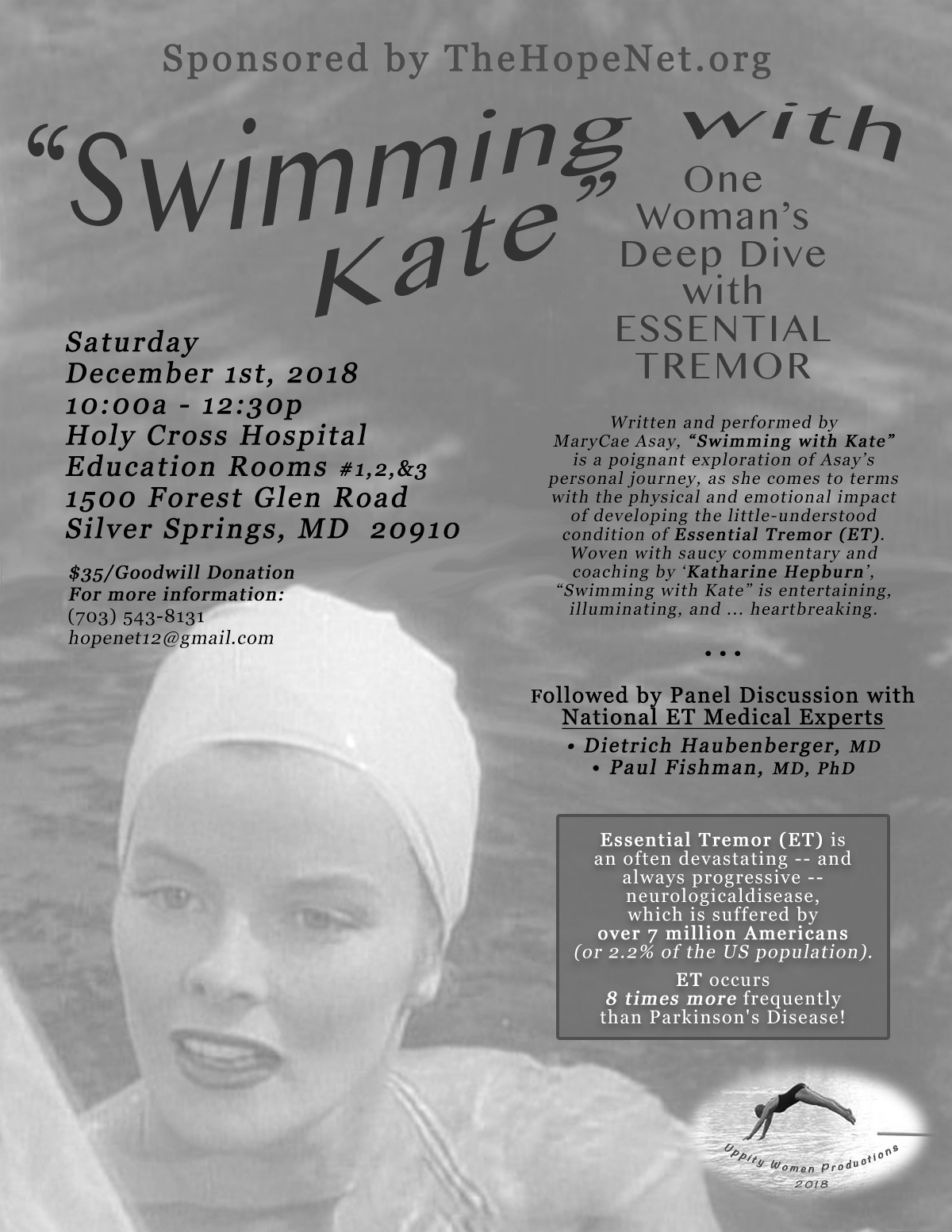
Living with Essential Tremor (ET)
NIH ET Trial with Research Doctor from Australia
 I have participated in many ET trials at the National Institute of Health (NIH) located in Bethesda, Md. – just outside Washington. It is an outstanding organization whose work benefits the whole world. As such, NIH brings doctors from all over the world to work there.
I have participated in many ET trials at the National Institute of Health (NIH) located in Bethesda, Md. – just outside Washington. It is an outstanding organization whose work benefits the whole world. As such, NIH brings doctors from all over the world to work there.
I am now participating in a new trial at NIH conducted by Dr. Dietrich Haubenberger. He is great and from Vienna. For this trial, he is being assisted by Dr. Alex Fois of the University of Sydney. My ET is hereditary. My mother had it as did her mother. They were Australian (Perth). I therefore have unknown relatives in Australia who have ET.
We at HopeNET want to be of help to anyone who has ET regardless of where they are in the world or their circumstances. It was a real pleasure spending time with Dr. Fois.
— Peter Muller
Dr Alessandro Fois BSc (Adv; Hons I, Medal) BM BCh (Oxon) MRCP FRACP
Clinical Associate Lecturer, University of Sydney
Movement Disorders Fellow
Department of Neurology – A/B Block Level 1 Westmead Hospital
What does it mean to have a disorder like ET?
 What does it “mean” to have a disorder like ET? It’s not a disease. As you and I know it’s probably more like an umbrella term covering a family of different problems all united by one primary symptom – tremor. How do we gain more knowledge about ET and our own conditions? Having a visible tremor is a “sign” to others that there is something wrong with our brains. What this means to others has a direct bearing on what it means to us. And it’s not easy to communicate what it’s like to have ET to others, including health professionals. So how do we know what is important to communicate?
What does it “mean” to have a disorder like ET? It’s not a disease. As you and I know it’s probably more like an umbrella term covering a family of different problems all united by one primary symptom – tremor. How do we gain more knowledge about ET and our own conditions? Having a visible tremor is a “sign” to others that there is something wrong with our brains. What this means to others has a direct bearing on what it means to us. And it’s not easy to communicate what it’s like to have ET to others, including health professionals. So how do we know what is important to communicate?
New research comes out, and it’s hard not to personalize it and assume that whatever it says applies to me or to be upset that it clearly doesn’t apply to me! There are many studies of people with ET that show an inflated rate of this or that among people with ET. As an epidemiologist, let me tell you the main problem I have with some of these studies: many of these studies don’t bother to provide or consider the base rate—this is the rate of a particular disorder in the general population, and it helps one understand whether a finding means anything in particular.
Let’s take depression for instance. A study tells you that X% of those with ET also have depression. Gosh, you might say, this may mean my ET makes it more likely that I’ll be depressed. (Well if you kept missing your mouth when you tried to eat peas or apply lipstick, you might also have some general distress towards your functioning – but hey, that’s distress, not depression, which is a clinical diagnosis with many symptoms over at least a two-week time span). What the researchers often don’t tell you is whether this rate is more or less than in the population at large. In fact, depression is a prevalent problem in the general population! Here’s where I have to get a little specific. Again, depression requires a group of symptoms that occurred for at least a two-week period. So if we are asking people about the last two weeks, all we can find is if they are currently in a two-week period of depression. If they started coming out of it a week ago, we won’t accurately measure the fact that in the last 30 days they have been depressed. If we measure the last 30 days only, we won’t know if they had a depressive episode last month that may have resolved enough – not completely, but enough – for them not to reach diagnostic criteria. Finally, if we measure lifetime, we might find out if they have EVER had depression. This ever category is always the biggest. It counts the prevalence of past-30-day (commonly called current) depression and it counts any lifetime episode. Measured this way, one in five people in the U.S. has ever been depressed. So if a study measures the association of depression, lifetime, with ANYTHING, it is very likely to be positive, to look elevated, if you don’t account for the base rate of the disorder in the population. I’m only using depression as an example. The bottom line is that we have to remember when we read the literature that just because someone finds that something is associated with ET doesn’t necessarily mean much. It doesn’t mean with our type of ET we are at higher risk for another disorder or disease.
So what do we need to be communicating to health professionals and, in turn, to researchers? What don’t they know that prevents them from being able to help us with? What about that my hand tremor is only a small part of what my ET is and how it affects me. Lately when I’m laying down to sleep, my neck and head tremor bother me and keep me from falling asleep. I try to get in a position that will lessen it, but I find it difficult to do. I’m still taking less propranolol than I could; maybe it would go away if I took more, or really cut out caffeine from my diet. I also realize that for years I’ve been clenching my jaws to cut down on jaw tremor. Not good for the enamel on my teeth or for my joint! Here’s another weird one – maybe you can relate, maybe not. When someone picks a table that will cause people to sit really close together, or in theaters or other places where the chairs are really small, and some of the people just have to spread their legs and take up lots of space, I’ll be really uncomfortable. Why? Because I’ll be almost forced to activate my muscles to hold my legs closely together, and that will lead to tremor, and then I’ll be really uncomfortable; and honestly it’s hard for me to even communicate what I’m talking about to people who don’t have a tremor. Actually I think the list of what I don’t share about my ET is huge. I didn’t realize it until I started writing this! And that’s just about different tremors, probably not the most important thing about ET to me.
That is the feeling I get when I forget to take my medicine. I feel off balance, like something inside knows something isn’t quite right. And I don’t really see that reflected in the literature. What is in the literature may not at all reflect my ET. It might not reflect yours. That puts an additional burden on each of us to communicate how ET affects us for our own sake, and to build the knowledge base about how ET affects people. I’m hoping we’ll make progress in understanding and treating what we now call ET. It’s going to take new research – but it’s also going to take persons with ET speaking up about what matters most.
——-
Dr. Catherine Striley is a professor of epidemiology at the University of Florida, Gainesville and has had ET since her early childhood. She therefore has the condition while being a member of the medical community.
There Is Still Time To Donate in 2017!
Thank you for your charitable support of HopeNet’s mission!! We are focused on increasing awareness and also facilitating better treatments for ET. Click HERE to go to our Donate page.
General Essential Tremor Information
We link to Mayo Clinic’s award-winning website for knowledge and health information: MayoClinic.org Essential Tremor Information.
Act Now and Give Your Public Comment on Focused Ultrasound Procedure
If you suffer from Essential Tremor and are interested in receiving the non-invasive procedure Magnetic Resonance guided Focused Ultrasound (MRgFUS)……
YOU NEED TO ACT NOW!!!
National Government Services (NGS Medicare), the Local Medicare Contractor that oversees benefit administration for Medicare beneficiaries residing in the following states: Connecticut, Illinois, Maine, Massachusetts, Minnesota, New Hampshire, New York, Rhode Island, Vermont, and Wisconsin recently published a “DRAFT” Local Coverage Determination (LCD) on the topic of MRgFUS for essential tremor. While NGS feels the technology is “promising”, they came to the conclusion that they will NOT consider this procedure to be a covered benefit. This is very disheartening as MANY people who suffer from tremor could benefit from this procedure.
NGS Medicare is allowing public comments on the subject through November 30, 2017. Without significant written comments by the public, the draft policy will likely be finalized in its current unfavorable decision.
If you would like to submit comments, encouraging NGS Medicare to provide coverage for its Medicare beneficiaries, you can do so by sending them electronically. Please reference the following in your subject line: Re: Magnetic Resonance Image Guided High Intensity Focused Ultrasound (MRgFUS) for Essential Tremor: DL37421
The email address for submitting comments is: PARTBLCDCOMMENTS@anthem.com
Act Now and Give Your Public Comment on Focused Ultrasound Procedure
If you suffer from Essential Tremor and are interested in receiving the non-invasive procedure Magnetic Resonance guided Focused Ultrasound (MRgFUS)……
YOU NEED TO ACT NOW!!!
National Government Services (NGS Medicare), the Local Medicare Contractor that oversees benefit administration for Medicare beneficiaries residing in the following states: Connecticut, Illinois, Maine, Massachusetts, Minnesota, New Hampshire, New York, Rhode Island, Vermont, and Wisconsin recently published a “DRAFT” Local Coverage Determination (LCD) on the topic of MRgFUS for essential tremor. While NGS feels the technology is “promising”, they came to the conclusion that they will NOT consider this procedure to be a covered benefit. This is very disheartening as MANY people who suffer from tremor could benefit from this procedure.
NGS Medicare is allowing public comments on the subject through November 30, 2017. Without significant written comments by the public, the draft policy will likely be finalized in its current unfavorable decision.
If you would like to submit comments, encouraging NGS Medicare to provide coverage for its Medicare beneficiaries, you can do so by sending them electronically. Please reference the following in your subject line: Re: Magnetic Resonance Image Guided High Intensity Focused Ultrasound (MRgFUS) for Essential Tremor: DL37421
The email address for submitting comments is: PARTBLCDCOMMENTS@anthem.com
Is Long Term Care Coverage an Option for Those with Essential Tremor?
Beware The Insurance Companies
In January of 1993, I (Wayne Givens) was employed by the Eastman Kodak Company and a group Long Term Care (LTC) insurance policy was offered to employees at an attractive rate. I enrolled in a policy for myself and also one for my wife with Metropolitan Insurance Company (MetLife). The premiums were $50 per month for each of us. The policies when used would provide for $100 per day maximum for an assisted living home or full skilled nursing home and/or $100 per day maximum for in home care. I am 78 years old and have been dealing with ET (severe tremor with my hands) for almost 25 years. In January of 2016 my wife of 54 years was diagnosed with severe cognitive impairment/dementia. After many discussions with our son and daughter, we decided we could no longer live independently. With their help, we found an assisted living home that would meet our requirements (Morningside House in Leesburg, VA). After a thorough review by MetLife, we both qualified for our LTC policies and moved into Morningside House in May of 2016.
I quickly learned that a claim filing for the actual expenses for each policy was required every month. With both policies, the $200 per day covered about 85% of our expenses at Morningside House. The major reason for the monthly filings is to avoid paying taxes on the monthly payouts.
Everything was going along well but then on June 30, 2017 I received a phone call from MetLife informing me that after a medical review my benefits (not my wife’s) were being terminated effective July 1, 2017. I was told I would receive a letter in the near future detailing the reasons for this action and also the process to make an appeal. I was shocked and told the person calling that this was not fair and to take such action with no advance notice was unethical. She told me that MetLife had the right to take such action in accordance with my policy.
When I received their letter, I learned that severe cognitive impairment/dementia automatically qualifies for LTC benefits but that it was not as clear for someone with ET. They focus on ADL’s (activities of daily living) which are dressing, eating, bathing, transferring, toileting, and continence. As most of you know with ET, there are many gray areas with how these areas are affected for each of us. They singled out the fact that I was still driving my car was an indication that my tremor must not be too severe. There was a clear lack of understanding as to what problems ET can cause.
In my appeal, a letter from my Neurologist pointed out that with ET when your hands are at rest (as in holding onto the steering wheel) there is no tremor which is not true for Parkinson’s Disease. Peter Muller wrote a nice email for my appeal pointing out that he has conducted support group meetings for people with ET for a number of years and hundreds of people with ET have driven to these meetings over the years without a problem. I reached out to 4 of my doctors to see if they would write letters in support of my appeal. They all very nicely responded, and I know these were very helpful for my appeal. I submitted my appeal on July 20, 2017.
After many phone calls and several more letters including one from the Director of Morningside House to MetLife, I received a phone call from my appeal coordinator at MetLife indicating that my appeal was approved and that benefits were being reinstated retroactive to July 1, 2017 and that I would receive a letter to make this official. I thanked the person calling me and felt like asking her if an apology was being made by MetLife. I did not ask this and no apology was included in the letter. I did ask if I had to go through this ordeal every year and the answer was that a review will be made each year. We will see. Insurance companies do not like to pay out on their policies and this is one example of that fact.
— Wayne Givens
Interested in Participating in a Clinical Trial for Essential Tremor?
If you live in or near any of these U.S. locations you may want to consider this trial, called the T-Calm Study, detailed on the flyer. There are a number of sites across the country where you can participate:
-
-
- Ann Arbor, MI
- St. Louis, MO
- West Palm Beach, FL
- Farmington Hills, MI
- Nashville, TN
- Boca Raton, FL
- Raleigh, NC
- Atlanta, GA
- New York, NY
- West Bloomfield, MI
- Savannah, GA
- La Jolla, CA
- Kansas City, KS
- Tampa, FL
- Boston, MA
- Houston, TX
- Chicago, IL
-
More information about the study and about the clinical-stage pharmaceutical company, Cavion, Inc., can be found here and here.
Cavion-TCalm-Flyer-Digital_IRB Approved_100217